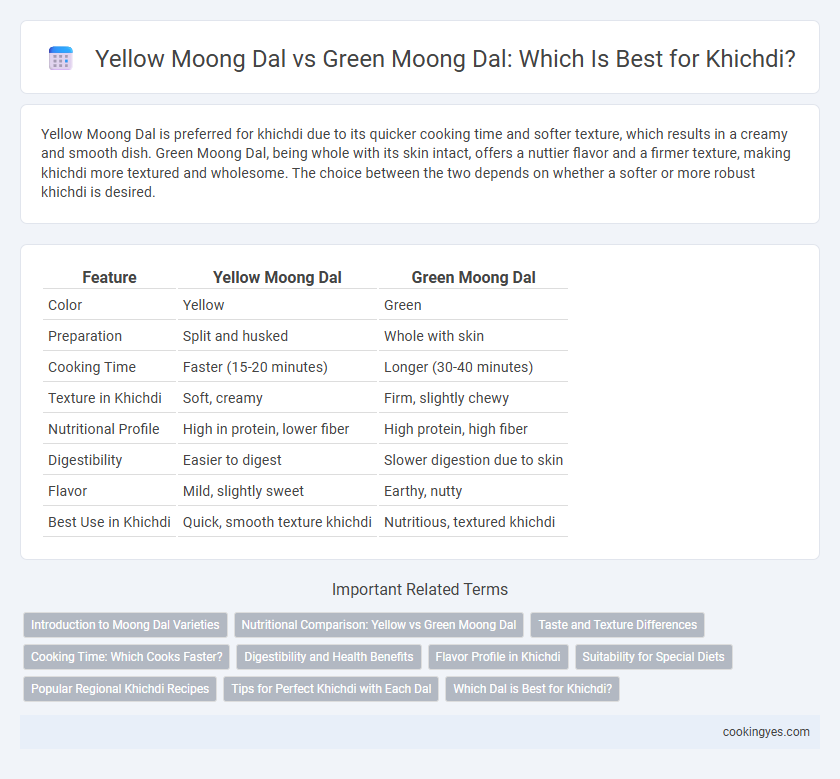Yellow Moong Dal is preferred for khichdi due to its quicker cooking time and softer texture, which results in a creamy and smooth dish. Green Moong Dal, being whole with its skin intact, offers a nuttier flavor and a firmer texture, making khichdi more textured and wholesome. The choice between the two depends on whether a softer or more robust khichdi is desired.
Table of Comparison
| Feature | Yellow Moong Dal | Green Moong Dal |
|---|---|---|
| Color | Yellow | Green |
| Preparation | Split and husked | Whole with skin |
| Cooking Time | Faster (15-20 minutes) | Longer (30-40 minutes) |
| Texture in Khichdi | Soft, creamy | Firm, slightly chewy |
| Nutritional Profile | High in protein, lower fiber | High protein, high fiber |
| Digestibility | Easier to digest | Slower digestion due to skin |
| Flavor | Mild, slightly sweet | Earthy, nutty |
| Best Use in Khichdi | Quick, smooth texture khichdi | Nutritious, textured khichdi |
Introduction to Moong Dal Varieties
Yellow Moong Dal and Green Moong Dal are two popular varieties of moong beans commonly used in Indian cuisine, particularly for making khichdi. Yellow Moong Dal is split and hulled, resulting in a softer texture and quicker cooking time, ideal for creating the creamy consistency desired in khichdi. Green Moong Dal is whole and unhulled, offering a nuttier flavor and higher fiber content, which adds a subtle crunch and more nutritional benefits to the dish.
Nutritional Comparison: Yellow vs Green Moong Dal
Yellow moong dal has slightly lower fiber content but is rich in carbohydrates and easy to digest, making it a preferred choice for khichdi recipes aimed at quick energy and light meals. Green moong dal offers higher protein, fiber, and antioxidant levels, contributing to better digestion and prolonged satiety. Both dals provide essential nutrients like iron, potassium, and B vitamins, with green moong dal having a nutritional edge for those seeking enhanced health benefits in khichdi.
Taste and Texture Differences
Yellow moong dal offers a mild, slightly sweet flavor that blends seamlessly into khichdi, creating a soft and creamy texture ideal for comfort food. Green moong dal, with its earthier taste and firm texture, adds a nutty depth and a bit more bite, making the dish heartier and more textured. The choice between yellow and green moong dal fundamentally affects the khichdi's overall mouthfeel and flavor profile, catering to either a smooth or robust culinary experience.
Cooking Time: Which Cooks Faster?
Yellow Moong Dal cooks faster than green Moong Dal due to its split and polished form, which reduces cooking time significantly, making it ideal for quick khichdi preparation. Green Moong Dal, being whole and unpolished, requires longer soaking and extended cooking to soften adequately. For speedy and creamy khichdi, yellow moong dal is the preferred choice.
Digestibility and Health Benefits
Yellow moong dal is easier to digest due to its husked, split nature, making it ideal for light meals like khichdi, especially during digestive sensitivity. Green moong dal, containing the husk, offers higher fiber content contributing to better gut health but may be slightly heavier on digestion. Both dals provide essential plant-based protein, antioxidants, and vitamins, supporting cardiovascular health and immune function, with yellow moong dal being the preferred choice for quick nutrient absorption.
Flavor Profile in Khichdi
Yellow Moong Dal offers a mild, slightly nutty flavor with a soft texture, making it ideal for creamy, comforting khichdi. Green Moong Dal has a more robust, earthy taste and firmer texture, providing a heartier bite and richer aroma in khichdi preparations. The choice between the two influences the dish's overall flavor intensity and texture, with yellow moong dal creating a smoother, subtler profile, while green moong dal adds depth and complexity.
Suitability for Special Diets
Yellow Moong Dal is highly suitable for special diets due to its easy digestibility and low fiber content, making it ideal for individuals with sensitive stomachs or those recovering from illness. Green Moong Dal, while nutritious and rich in antioxidants, contains a higher fiber content that may be less suitable for low-fiber or bland diet requirements. For khichdi, yellow moong dal offers a smoother texture and gentler impact on digestion, enhancing its compatibility with gluten-free, low-fat, and diabetic-friendly meal plans.
Popular Regional Khichdi Recipes
Yellow moong dal is commonly used in North Indian khichdi recipes for its mild flavor and quick cooking time, giving the dish a soft, creamy texture. Green moong dal, favored in Gujarati and Maharashtrian khichdi, retains its shape and adds a slightly nutty taste, enhancing the dish's nutritional value with higher fiber content. Regional variations highlight yellow moong dal in comfort foods like Bengali khichuri, while green moong dal appears in more protein-rich, hearty adaptations across western India.
Tips for Perfect Khichdi with Each Dal
Yellow Moong Dal offers a softer, creamier texture ideal for khichdi that cooks quickly, while Green Moong Dal provides a firmer bite and more pronounced flavor, requiring longer soaking and cooking times. For perfect khichdi with Yellow Moong Dal, rinse thoroughly and cook on medium heat to avoid mushiness, adding turmeric and gentle spices for balanced taste. When using Green Moong Dal, soak for at least 2-3 hours, adjust water quantity to prevent dryness, and simmer slowly to achieve tender grains with a rich, nutty flavor.
Which Dal is Best for Khichdi?
Yellow Moong Dal is best for khichdi due to its quick cooking time and smooth texture, resulting in a creamy and easily digestible dish. Green Moong Dal, while nutritious with higher fiber content, takes longer to cook and retains a firmer texture, which may impact the softness desired in traditional khichdi. For optimal taste and digestibility, yellow moong dal is preferred in khichdi recipes.
Yellow Moong Dal vs Green Moong Dal for Khichdi Infographic

 cookingyes.com
cookingyes.com